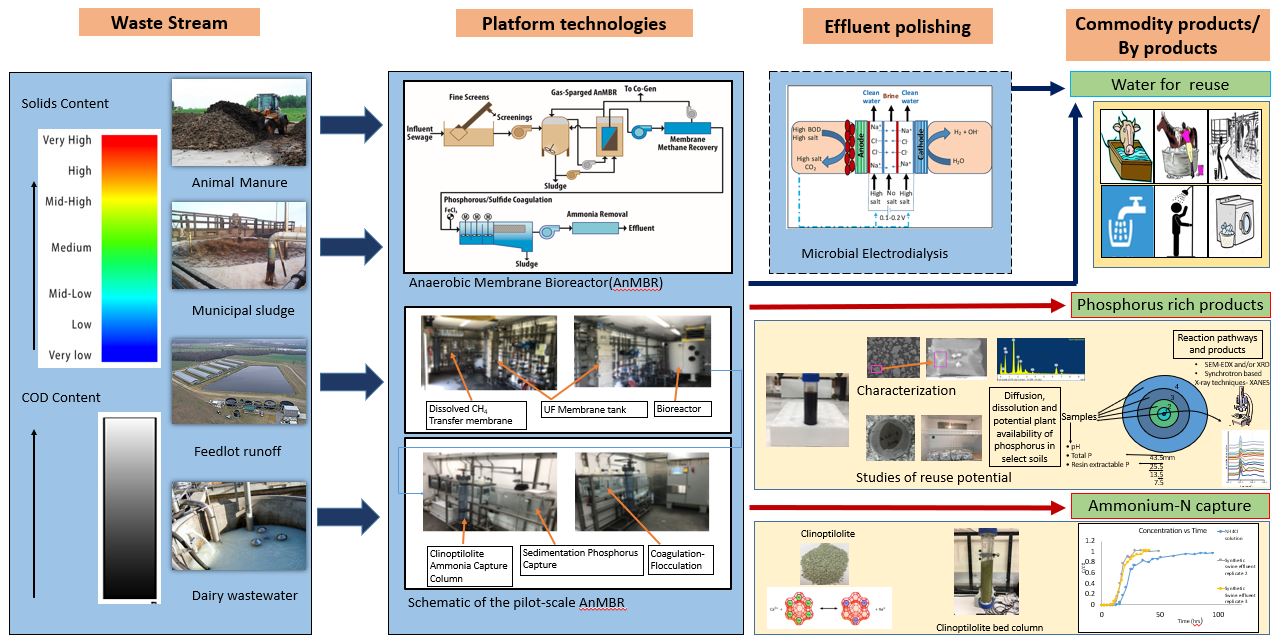Research Programs
The Hettiarachchi Lab explores various aspects of soil and environmental chemistry. Below are brief descriptions of our diverse research programs.
Bioavailability-based Sustainable Strategies for Risk Reduction of Lead in Residential Neighborhood Soils
Lead (Pb) is the most common contaminant found in urban soils. Lead concentration in urban soils can be highly variable and within small areas can range from background of around 20 mg/kg to over 1,000 mg/kg, while in Kansas City, we have seen ranges from background (~40 mg/kg) to over 4,448 mg/kg. The total concentration of Pb in soil or other environmental media is not a strong indicator of bioavailability and toxicity of Pb to humans or other environmental endpoints. In situ stabilization of Pb using soil amendments such as phosphorus (P) focuses mainly on reducing its human health and environmental risk by inducing biogeochemical reactions that convert soil Pb to forms with low bioavailability. In situ soil Pb stabilization can be achieved through chemical alteration and confirmed by speciation analysis.
Project Goals:
The primary research activity of this project is concentrated on Part 1, the Bioaccessibility Field Survey, to identify soil amendments to reduce bioaccessibility of lead in urban vacant and residential soils. Part 2 is the implementation of science action to help pave the way for bringing the most promising Pb soil mitigation strategies from the laboratories and testing grounds to real-world vacant and residential yards and families, and to engage and educate communities on the need for, and potential benefits of, these soil treatments.
Our Responsibilities:
Graduate research assistant Janani Madanayake will investigate how urban vacant lot sites reduce bioaccessible soil lead using (P) fertilizer, biochar, modified biochar, and/or their combinations at about 6-8 potential test sites. This study will investigate the in situ stabilization of contaminants using soil amendments, focusing mainly on reducing their human health and environmental risks by biogeochemical reactions that convert soil contaminants to forms with low bioavailability.
Graduate research assistant Rebecca Johnson will investigate current or past LHC program residences with high soil lead and develop an appropriate and acceptable P soil treatment specification for integration into the current LHC lead intervention protocol, and implement it on identified LHC residences.
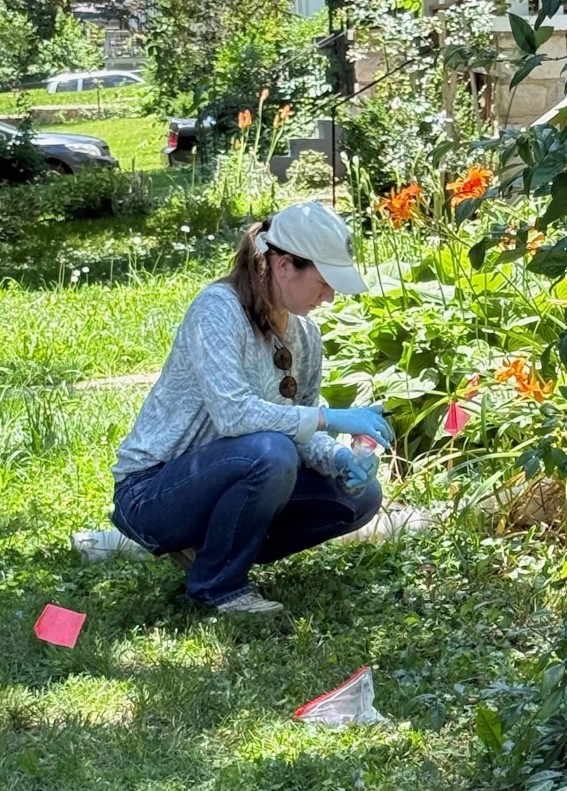
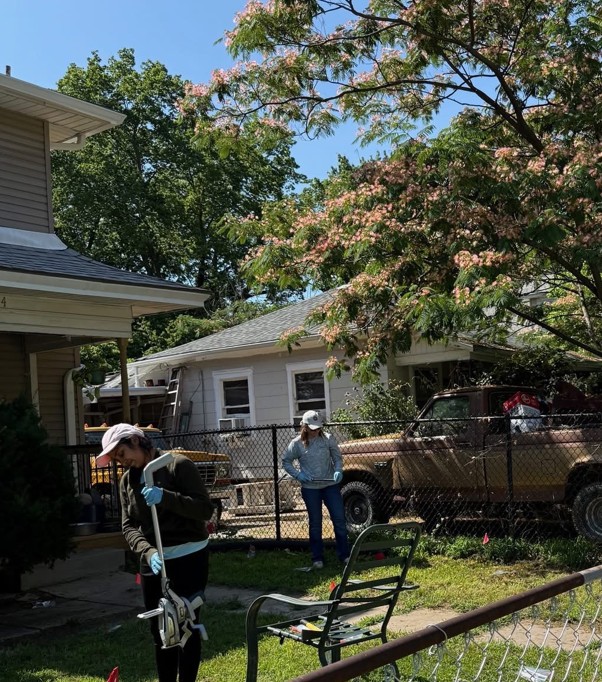
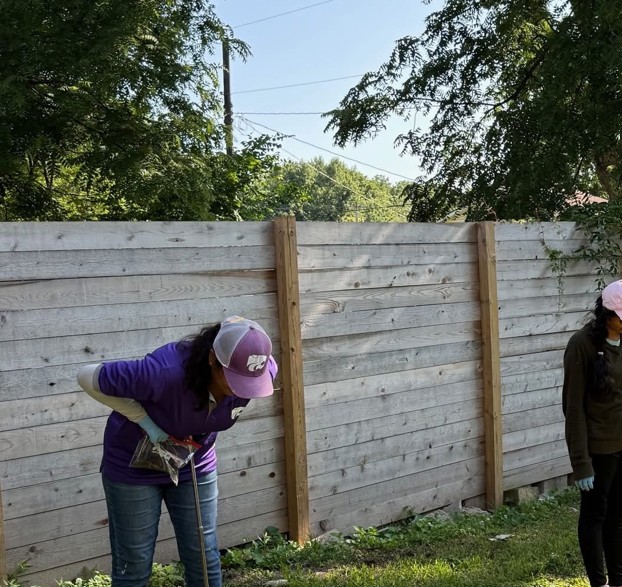
Funding Sources: U.S. Department of Housing and Urban Development
Collaborators: U.S. Environmental Protection Agency; Unified Government of Wyandotte County, Kansas City, Kansas; Wyandotte County Public Health Department, Kansas City, KS; and Health Department, City of Kansas City, MO
*************************************************************************************************
Reducing Bioavailability of Lead in Urban Residential Neighborhood Soil in Kansas City, Missouri
Young children in Kansas City’s urban core, where some lead poisoning rates exceed 9 times the national average. Nearly 50% of parcels tested exceed EPA’s play area lead threshold (400ppm), likely causing intransigent elevated blood lead levels (BLL), according to the health department. Research is lacking in the quantification of bioaccessibility and health risk reductions, especially for urban soils. This project will produce verifiable risk reduction data critical to developing affordable strategies to mitigate lead in urban soils, and correlate child BLL data with treated areas to identify potential health protection benefits.
Approach:
In situ stabilization using soil amendments (e.g., phosphorus, iron minerals, and exceptional quality biosolids) is proven to reduce soil health risk by inducing biogeochemical reactions converting lead to forms with low bioaccessibility. This targeted community health study is designed to measure the effectiveness of in situ stabilization treatments at reducing lead bioaccessibility in urban soils. Study objectives include: 1) identify improved, cost-effective protocols to manage commonly elevated urban soil lead; 2) build community capacity to target these protocols where they are most needed to prevent child lead poisoning; and, 3) determine efficacy of mitigation. Also investigates the sources of anthropogenic lead pollution in Kansas City through isotope ratio analysis of lead.
![]()
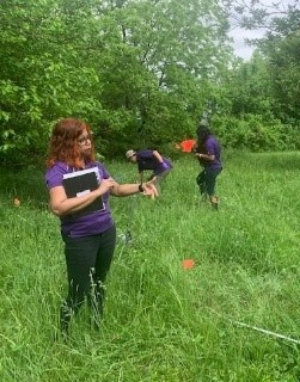
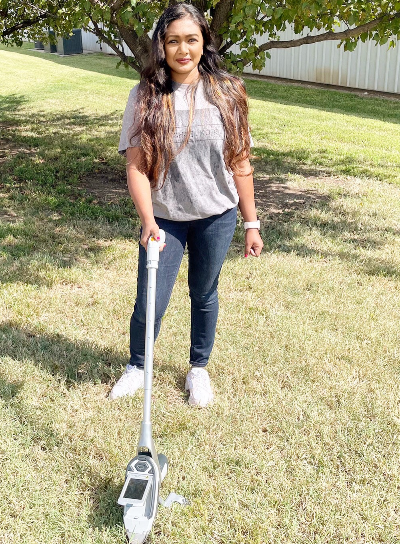
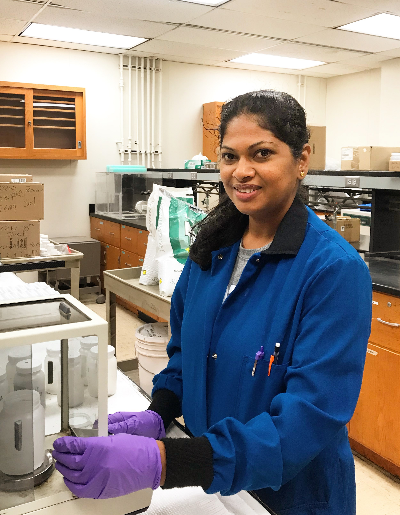
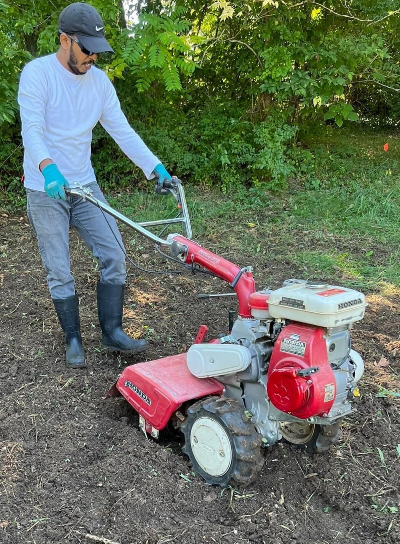
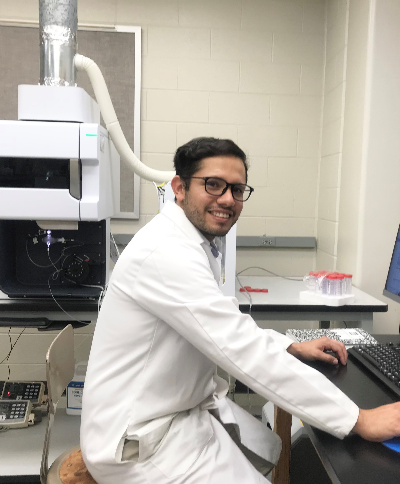

Funding Sources: U.S. Department of Housing and Urban Development
Collaborators: Department of City Planning & Development, City of Kansas City, Missouri; Health Department, City of Kansas City, Missouri, U.S. Environmental Protection Agency; and Children’s Mercy Hospital
*************************************************************************************************
Impacts of soil wetting bacteria and biochar on nutrient transformations in soils
This research is part of an interdisciplinary project, "Supporting rural livelihoods in the water-stressed Central High Plains: Microbial innovations for climate-resilient agriculture (MICRA)," conducted in collaboration with teams from the University of Nebraska-Lincoln and Langston University. In the face of climate change in the Central High Plains, preservation of soil moisture under drought stress is a critical objective for both rainfed and irrigated conditions. The team will determine if these microbially active soil amendments can be a long-term part of the solution to the challenges brought about by warmer climates.
Project Goals:
The MICRA project aims to investigate the impacts of soil-wetting bacteria and biochar on water-holding capacity and study the effects of these soil amendments on evapotranspiration, microbial communities, nutrient availability, and plants’ responses to drought stress, as well as irrigators’ perceptions of soil amendments and barriers to their adoption.
Project Approach:
This project operates under three thrusts. Thrust 1 investigates the impacts of soil-wetting bacteria on water transport. Thrust 2 examines the effects of soil-wetting bacteria and biochar on plant growth, while Thrust 3 investigates the techno-socioeconomic impacts of soil-wetting bacteria in irrigated fields.
Our responsibilities:
Our lab investigates the impact of wood-based and oat hull biochar, as well as soil-wetting bacteria (Bacillus subtilis), on soil nutrient dynamics and plant productivity using short-term laboratory incubation studies, greenhouse experiments, and field trials.
For more information about this project, please visit: https://www.k-state.edu/micra/

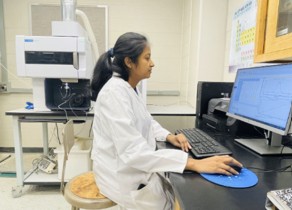
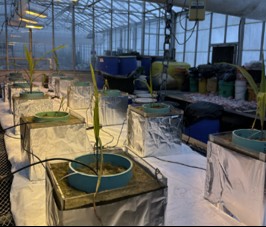
Funding Sources: National Science Foundation's Established Program to Stimulate Competitive Research (EPSCoR)
Collaborators: University of Nebraska-Lincoln and Langston University
*************************************************************************************************
Bioaccessibility, Speciation, and Characterization of Lead (Pb) in Household Dust Across the U.S
This interdisciplinary project evaluates the environmental and public health risks associated with lead (Pb)-contaminated household dust. Lead is a persistent and toxic heavy metal that poses serious health risks, especially to young children. Even at low levels, Pb exposure can impair neurological development, reduce IQ, and increase behavioral problems, making it a significant public health concern. One of the primary pathways for chronic, low-level exposure in urban environments is through household dust, which can become contaminated with Pb from deteriorating lead-based paint, historical emissions from leaded gasoline, industrial pollution, or contaminated soil tracked indoors. Children are particularly vulnerable due to hand-to-mouth behavior and increased absorption rates.
Utilizing previously collected dust samples from urban neighborhoods and new household-level data, this project analyzes Pb concentrations, bioaccessibility, chemical speciation, and nicotine levels. By integrating geospatial child blood lead level (BLL) data, the study aims to understand better the complex relationships between environmental exposure, behavioral risk factors such as indoor tobacco use, and childhood lead poisoning. Findings will inform targeted interventions and risk communication strategies aimed at reducing Pb exposure in high-risk communities.
The project also incorporates a household-based assessment to collect new environmental and survey data, with the ultimate goal of co-developing culturally appropriate and actionable risk communication tools for residents in impacted communities.
Project Goals:
To investigate the bioaccessibility, speciation, and potential sources of lead (Pb) in household dust across U.S. neighborhoods with a history of lead exposure, with the aim of supporting community-led risk reduction and improving public health outcomes for vulnerable populations, especially children.
Project Approach:
The study consists of two phases: a bioaccessibility field study and a household lead assessment. In Phase 1, we will analyze previously collected dust samples from various states across the United States, including Indianapolis, IN, which represents a range of Pb levels from low to high. Samples will be tested for total Pb, bioaccessibility (using EPA Method 1340 and PBET), speciation (via X-ray Absorption Spectroscopy), and Pb isotopes. Results will be mapped and analyzed in conjunction with five-year child blood lead level (BLL) data to explore spatial patterns and correlations. In Phase 2, we will recruit 15 households from high-risk areas to collect new dust and soil samples and administer a household survey. These samples will undergo similar analyses, and findings will inform the development of risk communication tools to help families reduce lead exposure.
Our Responsibilities:
Graduate research assistant Nishadi Dodampe Mudiyanselage is responsible for laboratory analysis of lead (Pb) in household dust and soil samples, including total concentration, bioaccessibility, chemical speciation, and Pb isotope ratios. We will utilize validated EPA-approved methods, including the Physiological Based Extraction Test (PBET) and In Vitro Bioaccessibility Test (IVBA) protocols, as well as X-ray Absorption Spectroscopy (XAS), with strict adherence to quality assurance and control standards. We are also involved in the development of household survey instruments to ensure they capture relevant environmental and behavioral data.
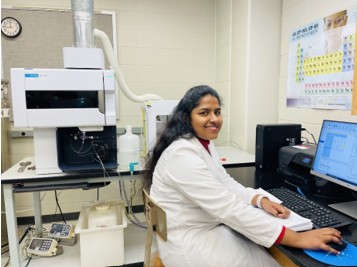
Funding Sources: US Department of Housing and Urban Development
Collaborators: Indiana University Bloomington, Indiana University Indianapolis
***********************************************************************************************
Impact of Fertilizer Management Strategy and Cover Crops on Phosphorus Loss, Bioavailability, and Sediment Speciation in No-Till Agricultural Watersheds
Phosphorus (P) runoff from agricultural fields is a leading contributor to surface water quality degradation, resulting in eutrophication, harmful algal blooms, and costly ecological damage. The Kansas Agricultural Watershed (KAW) Field Laboratory is an outdoor lab designed for the development of sustainable agricultural systems and the evaluation of their effects on water quality. The goal is to provide producers with flexible management options that maximize profitability while protecting soil and water resources.
This long-term field study examines the impact of various fertilizer management strategies and cover crop practices on phosphorus loss, bioavailability, and chemical speciation in surface runoff and sediments within a no-till corn-soybean rotation system. Over three distinct phases, from 2014 to the present, the project has transitioned from evaluating various P application methods to focusing on two contrasting P management strategies: Build and Maintain and Build and Drawdown, combined with consistent cover crop (cereal rye) and no-cover treatments.
Study Goals:
The goal of this study is to evaluate how long-term phosphorus fertilizer management and cover cropping influence P availability, mobility, and speciation in both soils and surface runoff sediments. By identifying key P forms and their transformations under different BMPs, the study aims to improve fertilizer efficiency, reduce environmental P losses, and enhance soil and water quality sustainability in no-till agricultural systems.
Project Approach:
The study includes three main phases. Phase 1 (2014–2019) examined the impact of different P fertilizer methods - fall-applied DAP, spring-injected APP, and no P- alongside cover cropping on runoff P loss. In Phase 2 (2020–2022), P strategies were streamlined into two categories: Build and Maintain (BM), which involved continuous spring-injected APP to sustain elevated P levels, and Build and Drawdown (DD), where fertilizer was withheld to gradually reduce soil P levels. In Phase 3 (2023–present), these strategies evolved to include maintenance-level P applications in DD plots, while BM plots continued to receive APP applications. Cover crop treatments remained constant across all phases.
Surface runoff sediments are collected after each rainfall event. Each sediment sample undergoes a modified sequential extraction (SEDEX) procedure to separate operationally defined P fractions (e.g., exchangeable, organic-associated, Fe/Al-bound, Ca-bound, and residual P). Fractions are analyzed using spectrophotometry or ICP-OES to quantify P concentrations. In addition to these wet chemical analyses, a subset of samples is analyzed using P K-edge XANES spectroscopy at the Advanced Photon Source (APS) to identify solid-phase P species directly. Combining sequential fractionation with synchrotron-based spectroscopy enables a deeper understanding of how management practices affect P mobility and availability in runoff sediments.
Our Responsibilities:
Graduate research assistant Nishadi Dodampe Mudiyanselage is primarily responsible for identifying and quantifying operationally defined phosphorus fractions in soil and sediment samples from runoff using a modified sequential extraction procedure. Following fractionation, we analyze each extract using UV-Vis spectrophotometry or Inductively Coupled Plasma Optical Emission Spectroscopy (ICP-OES) to determine the concentration of P in each pool. We also prepare and process freeze-dried, homogenized sediment samples for advanced spectroscopic analysis (P K-edge XANES) at the synchrotron facility. Our efforts provide the chemical and mechanistic foundation needed to assess and improve phosphorus management strategies in agricultural systems.
For more information about this project, please visit: https://www.k-state.edu/kaw/

Funding Sources: Kansas Department of Agriculture and Kansas Soybean Commission
Collaborators: Nathan O. Nelson, Kraig L. Roozeboom, Gerard J. Kluitenberg, Peter J. Tomlinson, DeAnn R. Presley at the Department of Agronomy, Kansas State University
*************************************************************************************************
Transdisciplinary Evaluation of Urban and Peri-Urban Agriculture (UPA) Types
This research project, funded by Kansas State University’s Game-changing Research Initiation Program (GRIP), focuses on the transdisciplinary evaluation of urban and peri-urban agriculture (UPA) systems. As food system challenges become increasingly complex, particularly in urban and peri-urban settings, there is a growing need to assess how these systems function not only in terms of food production but also in relation to environmental sustainability, community well-being, and food system resilience. To address these complexities, the project brings together researchers from various disciplines to collaboratively develop evaluation tools that provide a holistic understanding of UPA's contributions to the environment and society.
Project Goals:
The short-term goals of the project include building strong cross disciplinary partnerships and creating a comprehensive evaluation framework that can assess UPA’s impact. The long-term vision is to generate research that drives transformational change and supports global efforts to build sustainable and secure food systems. The outcomes of this research will be valuable to policymakers, planners, educators, and urban growers seeking data-driven strategies for managing UPA more effectively.
Project Approach:
To support this work, the project team is organized into four specialized working groups: WG1 focuses on agricultural productivity, WG2 on community health, WG3 on environmental sustainability, and WG4 on food systems resiliency. These groups are currently collecting and analyzing data from 24 UPA sites, primarily located across Kansas and Missouri. However, the research also has the flexibility to include additional regions as needed. The selected sites represent a wide range of urban and peri-urban agriculture types.
Our responsibilities:
Working Group 3 (WG3), graduate research assistant Lakma Upendri, is responsible for evaluating the environmental sustainability of UPA sites. This evaluation integrates multiple data sources, including a structured questionnaire survey, systematic on-site field observations, and laboratory analysis of soil samples, with a particular emphasis on potentially toxic trace elemental contamination.
By combining social and environmental data, the research seeks to identify the best management practices, highlight environmental challenges, and support the development of more environmentally responsible and resilient urban food systems.
For more information and to follow the progress of this project, please visit:
https://olathe.k-state.edu/research/urban-food/research/grip-award/
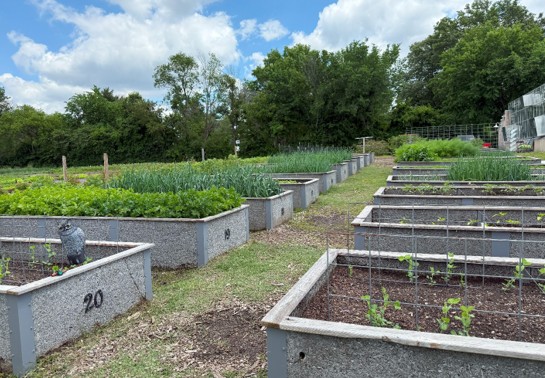
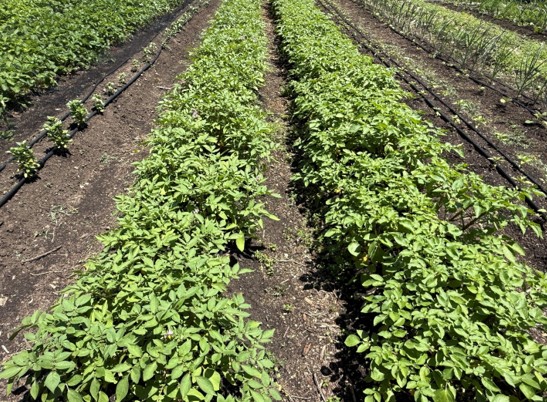
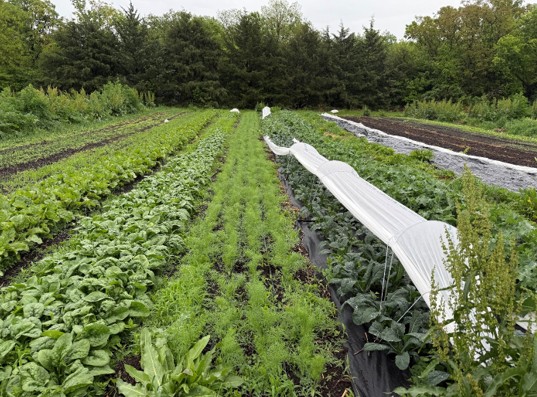
***********************************************************************************************
Understanding liquid phosphorus fertilizers with and without fulvic and amino acids in phosphorus-fixing acid and calcareous soil
Project Goals:
The project in industrial collaboration with ICL group aims to provide a comprehensive assessment of the solubility, mobility, and transformation of liquid phosphorus fertilizers. The outcomes of this study are expected to inform the development of next-generation P fertilizers that enhance nutrient efficiency in sustainable crop production systems while minimizing environmental and human health risks.
Our Responsibilities:
Graduate research assistant Anuj Poudel is working on integrating soil chemistry to improve the understanding of nutrient dynamics and fertilizer product transformation in soils, unraveling the underlying interactive reaction pathways and mechanisms through soil incubation, speciation, and wet-chemical techniques.
***********************************************************************************************
Resource recovery from wastewater for sustainable agricultural production systems
We hypothesize that innovative wastewater treatment technologies can produce the right water from different sources (such as swine wastewater) while recovering nutrients and producing soil amendments for crop production and protecting the environment. Anaerobic membrane bioreactors and Microbial Reverse Electrodialysis Cells are new technologies that can operate sequentially and remove harmful substances from wastewater to produce clean water for reuse. These processes also produce nutrient-rich co-products, enabling balanced and tailored nitrogen and phosphorus applications. The inclusion of new resource/reuse technologies will make agricultural production more sustainable, economical, and environmentally friendly by reducing food and water quality deterioration from land application of livestock wastewaters and increasing water availability. This transformation will have a global impact as confined animal production wastewaters are increasingly used in water-scarce areas in both developed and developing countries to meet food production and other demands.
Jack Murphy:
Jack is working on to characterize, analyze, and test various phosphorus nutrient products from reclaimed wastewater to help create a suitable alternative phosphorus fertilizer for cities.
Anuj Poudel:
Anuj primarily focuses on the soil application of recovered nutrient products (RNPs) derived from AnMBRs, in the form of ammonia-N, in combination with micronutrients and conventional fertilizers. The study aims to compare and evaluate different treatments through incubation studies to assess if sequestered N and micronutrient-rich fertilizers from wastewater enhance conventional fertilizers efficiency and overall nitrogen use efficiency.
Kasuni Gamage:
Kasuni's research focuses on evaluating the effectiveness of contrasting groups of recovered nutrient products (RNPs: Fe- and Ca-based) recovered from Fort Riley, Kansas municipal wastewater, synthetic, and real swine wastewater using an innovative anaerobic membrane bioreactor (AnMBR) technology. The objectives were to characterize the RNPs and compare the dissolution, transformations, and potential bioavailability of P in RNPs with conventional P fertilizers in selected calcareous, neutral, and acidic soils using short-term laboratory incubation studies.
Dissertation title: Sustainable phosphorus management: reuse of recovered phosphorous in agriculture and impact of agricultural management practices on phosphorus speciation
Collaborators: Prathap Parameshwaran, Department of Civil Engineering, KSU, Stacy Hutchinson, Department of Biological and Agricultural Engineering, KSU
***********************************************************************************************
Reducing Children’s Blood Lead Levels by Mitigating Household Lead Paint in Central El Paso, Texas
The reduction of higher levels of child lead exposure in the United States is a public health success story. Given the growing evidence and broad acceptance that no level of lead exposure is “safe” for children, attention must now turn to developing strategies for lowering child blood lead levels that continue to impact millions of children nationwide to undetectable levels. El Paso, Texas is one of over 3000 cities nationwide with un-renovated pre-1978 housing and continuing high risk of child lead exposure from un-remediated lead paint. Current state and local intervention strategies were conceptualized for isolated cases of higher level lead exposure. New cost-effective child-relevant mitigation strategies are needed that can provide intervention for clusters of children in high-risk neighborhoods. Over the past ten years, our studies of early lead exposure among the children of our region have contributed substantially to the literature on this problem, and our interdisciplinary team is now uniquely positioned to test a novel community-engaged mitigation strategy for private homeowners living in high-risk neighborhoods. We propose a strategy that uses a holistic approach that integrates neighborhood-level community engagement and education on child lead exposure hazards and solutions, with household-level lead hazard detection and mitigation. The approach maximizes scarce resources by: 1) spatially mapping real time child BLLs determined by ICP-MS in neighborhoods for identification of hotspots of child lead exposure; 2) using a late-generation x-ray fluorescence analyzer for efficient identification of possible home lead sources and bioaccessibility assays to narrow the focus of mitigation on likeliest child-relevant lead hazards; and 3) assisting home owners with low-cost mitigation of home lead exposure sources. In this study, we plan to test and refine these methods and demonstrate their efficacy with post-mitigation tests of child BLLs and home dust samples.
For more information on this project, please visit: https://www.utep.edu/leadresearchteam/index.html
Chandima Wekumbura:

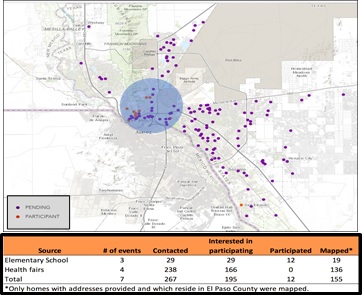
Funding source: US Department of Housing and Urban Development
Collaborators: University of El Paso, Texas; Drs. Christina Sobin, Carla Campbell and William Hargrove
***********************************************************************************************
Manipulating Nutrient Reaction Pathways to Optimize Nutrient Availability in Soils
Phosphorus (P) is an essential element for all life forms. However, it is one of the most difficult nutrients for plants to obtain from the soil and therefore, often represents a limiting factor to agricultural production. While P is needed in adequate quantities for optimal crop production, it has also been associated with eutrophication of surface water bodies. Knowledge of the dominant solid P species present in soil following application of P fertilizers and linking that to potential P availability would help understanding how to manage P efficiently in reduced tillage systems as well as in high P-fixing soils.
Similarly, millions of hectares of arable land worldwide, particularly in arid and semi-arid regions, are deficient in plant available Zn. Thus, various organic and inorganic Zn fertilizers have been used to correct their deficiencies. The inclusion of Zn in commercial macronutrient fertilizers is a common practice throughout the world and has been driven mainly by product physical characteristics than by considerations of fertilizer efficiency.
Approaches:

Sevendeep Kaur:
Thesis title: How do shuttle and slow-release effects of zinc fertilizers alter zinc diffusion in soil and its uptake by wheat plants?
Buddhika Galkaduwa:
The overall focus of Buddhika's research is to investigate how different sources of Zn in P fertilizers diffuse and react with soil and P using wet chemical, speciation and visualization techniques.
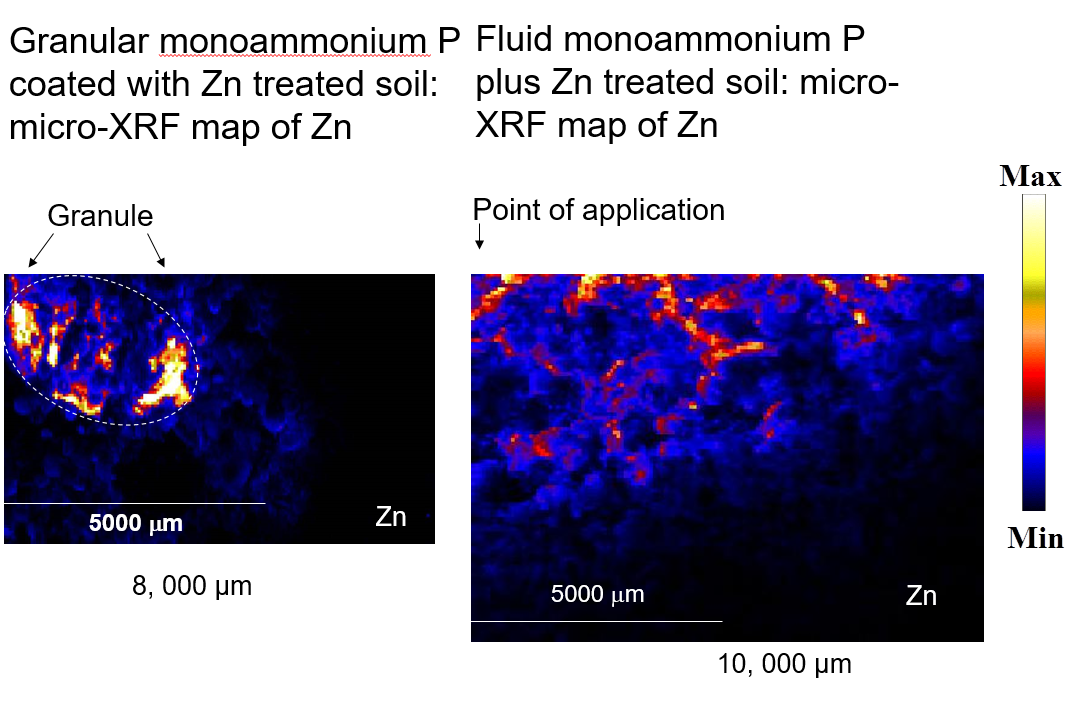
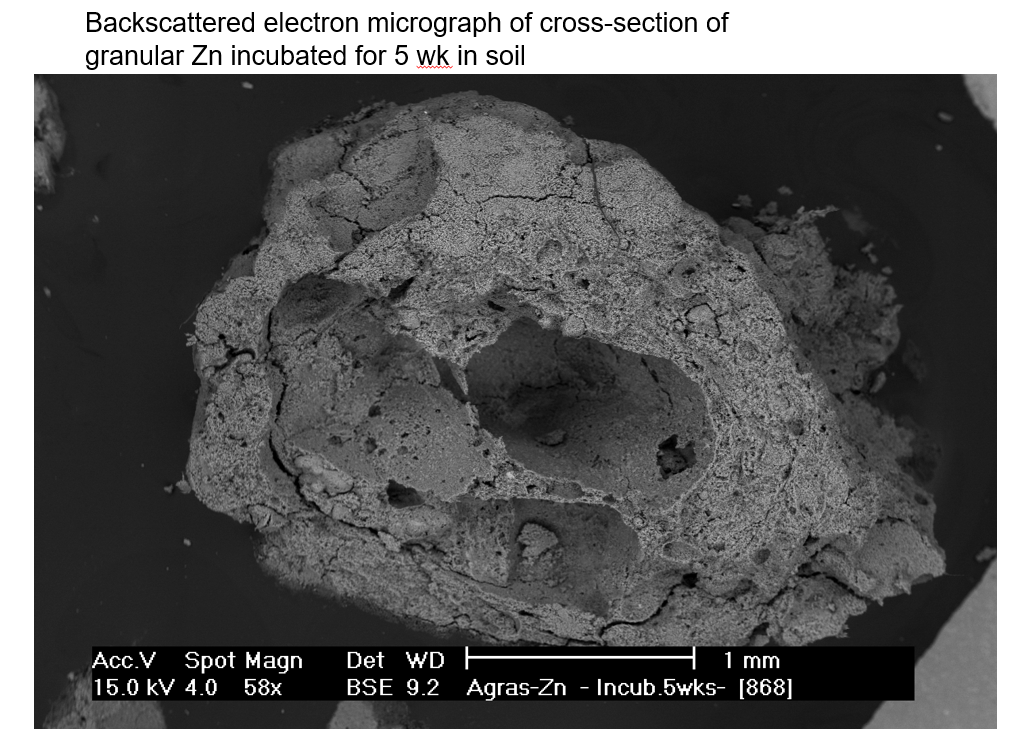
Joseph (Jay) Weeks:
Dissertation title: Improving environmental health: investigations into soil lead and phosphorus fate and transport
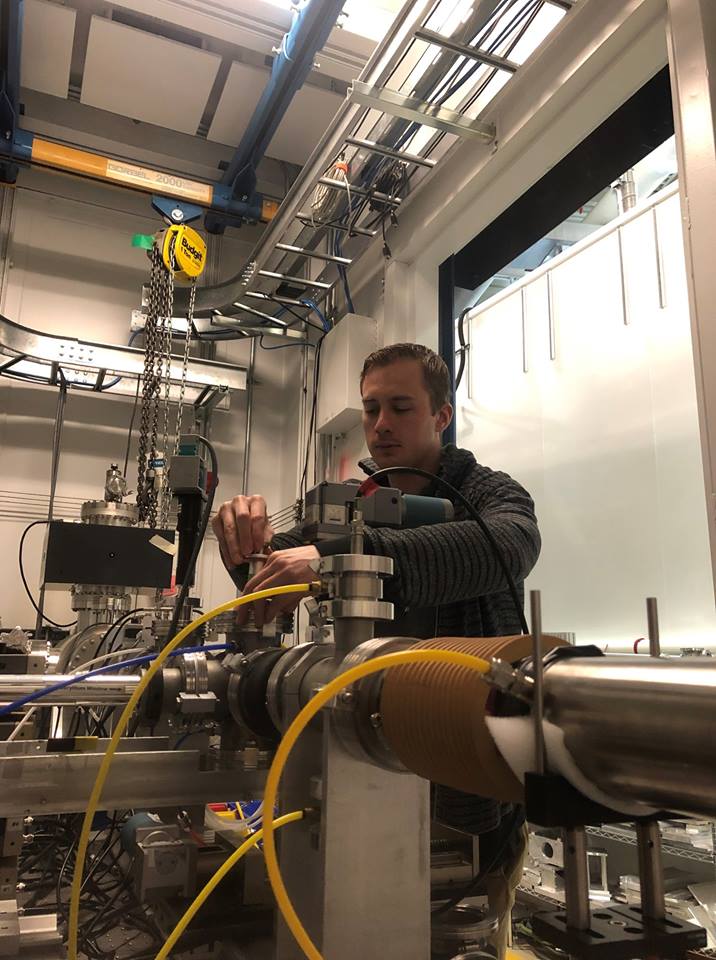
Mohammad Almutari:
Mohammad mainly focuses on micronutrient biofortification, transformations of trace elements and Treatment options for marginal waters.
Dissertation title: Improving crop quality: investigations on soil selenium and zinc transfer and bioavailability

Joy Pierzynski:
Joy focused on two separate studies aimed to understand the movement of phosphorus in soil. The first investigates P cycling within the organic fraction of native prairie soil, while the second attempts to understand phosphorus fertilizer reaction products, fate, and transport.
Dissertation title: The effects of P fertilizer addition on P transformations on high-P fixing and grassland soils
Raju Khatiwada:
Raju’s research focused on understanding the influence of placement (broadcast- vs. deep band-P), fertilizer source (granular- versus liquid-P) and time on reaction products of P in reduced-till systems.
Thesis title: Speciation of phosphorus in reduced tillage systems: placement and source effect
Rodrigo Silva:
Diffusion, Fate, and Reaction Products of Phosphate Fertilizers with Varying Solubility Applied to a Tropical Soil
*************************************************************************************************
Exploring the potential of sensing nutrient dynamics using soil-based microbial fuel cells
A soil-based microbial fuel cell (MFC) is a bio-electric device that uses soil microorganisms to convert an organic substrate into electricity. The energy generation potential of MFCs may be exploited to ‘sense’ the nutrient status of agricultural soils, which would be faster than traditional soil sampling methods and analysis in laboratories. It could provide real-time data on available soil nutrients.
Our studies focused on developing a soil-based MFC that tracks changes in nutrient availability and explores relationships between soil nutrient availability, microbial activity, and MFC performance. We hypothesized that 1) a change in the level of nutrients would produce a different microbial response; hence, a different electrical signal and 2) introducing a biofilm coating on the anode would enhance electrogenic microbial activity and its ability to capture changes in nitrogen dynamics and voltage.

Manjot Kuar:
Thesis title: Exploring the potential of sensing nutrient dynamics using soil-based microbial fuel cells
***********************************************************************************************
Soil contaminants exposure reduction pathways-Phytostabilization of contaminated sites
There is a great need to develop in-field monitoring studies to assess the possibility of growing a biofuel crops successfully in contaminated soils as a part of remediation of contaminated sites using phytostabilization technique.
Zafer Alasmary:
Zafer's research focus is safely using contaminated sites for biofuel crop production. He is studying how the contaminant uptake by crops and chemistry and quality of contaminated soils change with nutrient rich in situ soil treatments. This is a part of collaborative research effort began in 2016 between Eastern Europe and the United States, funded by North Atlantic Treaty Organization (NATO).
Dissertation title: Laboratory- to field-scale investigations to evaluate phosphate amendments and Miscanthus for phytostabilization of lead-contaminated military sites
For more information and the current progress of this project please visit: http://military-site-cleaning.cz/
***********************************************************************************************
Stabilization of mine waste materials
Lead and Zn were mined extensively in the Tri-State Mining Region for over 100 years, culminating in a multitude of environmental issues. Large areas are void of vegetative cover, smelter emissions have impacted communities, and vast quantities of mine wastes and soils enriched with Pb, Zn, and Cd remain. Phytostabilization, in situ stabilization via soil amendments, and sub-aqueous disposal of mine wastes are being studied as remediation approaches.
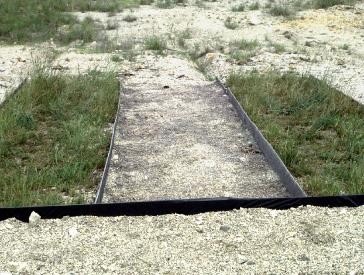
Ranju Karna:
Ranju devised a series of column experiments in order to better understand the chemical transformations that take place in the soil upon sub-aqueous disposal of mine wastes. By amending the mine waste materials with carbon and sulfur, she was able to elicit microbial responses that impact metal speciation.
Dissertation title: Mechanistic understanding of biogeochemical transformation of trace elements in contaminated minewaste materials under reduced condition
Vindhya Gudichuttu:
The overall focus of Vindhya's research was to monitor long-term effects of compost or lime additions at two different rates on soil properties, plants, and soil biota. She utilized the earthworm avoidance test as a screening tool for assessing effects of soil amendments on ecotoxicity.
***********************************************************************************************
Soil Carbon Sequestration - Effect of long-term agricultural management practices and changing climate
This facet of our research focuses on understanding process‐level physico- and biogeochemical mechanisms that control soil carbon (C) stabilization allowing for the development of climate change mitigation strategies. We assess the intra- and interrelationships between the physical, chemical, mineralogical, and biological processes that take place in our environment with our overarching goal being increased soil C retention.
Project Goals:
To investigate the coupled physicochemical and biogeochemical processes responsible for C dynamics and stabilization, to better understand how management alters the physicochemical and biogeochemical processes of soil C dynamics and stabilization, and to determine the resilience of the stabilized C under various temperature regimes.
Quantifying the relative contributions of the chemical, mineralogical and biological soil factors to carbon stabilization is needed to develop accurate and useful soil C models. The outcomes of our effort will help to develop/improve management options for climate change adaptation or mitigation.
Our Responsibilities:
Pavithra’s and Dorothy’s research aimed to gather information on how interactions between physical location, organic carbon chemistry, and mineralogy of soil aggregates contribute to soil organic carbon sequestration using an integrated approach. Currently, they are focusing on soil aggregates collected from two long-term field sites in temperate and tropical climates. The soils of interest were managed differently (e.g. tillage, crop rotation, manure addition, and/or fertilization) and led to varying levels of aggregation, soil C concentration/speciation, and microbial communities. Pavithra uses both new generation and traditional analytical techniques including NEXAFS-STXM, bulk NEXAFS, 13C NMR, HPLC, FTIR, XRD, SEM and other laboratory based wet chemical methods.
In-situ process-level biogeochemical mechanisms of C sequestration in microaggregates are being studied using NEXAFS-STXM spectromicroscopy. This research provides information on distribution and chemistry of C compounds, organo-mineral interactions and possible physical protection mechanisms. To achieve an accurate understanding of underlying biogeochemical mechanisms, aggregate architecture at the submicron scale must be carefully preserved. In the future Pavithra hopes to involve electron microscopy techniques to strengthen findings from the NEXAFS-STXM study. Bulk NEXAFS studies are useful in identifying chemical characteristics of soil organic carbon without any alteration to the natural structure of the molecules. Just as important as the structure, is the resilience of sequestered organic carbon to different temperature and moisture conditions. Planning for studies tackling this objective is taking place.
Dorothy’s research focused on understanding the role of microorganisms in carbon sequestration. She is specifically trying to understand how microbial community structure changes in temperate and tropical agroecosystems under changing climate.

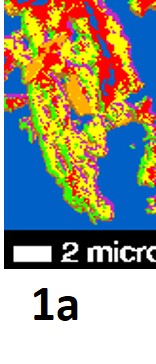

Pavithra Pitumpe Arachchige:
Dissertation title: Understanding of coupled physicochemical and mineralogical mechanisms controlling soil carbon storage and preservation
Dorothy Menefee:
Thesis title: Anthropogenic influences on soil microbial properties
***********************************************************************************************
Urban Brownfields Research
As the global population continues to grow towards the projected nine billion by 2050 and a greater proportion of the Earth’s residents dwell in cities, the availability of fresh, nutritious produce in densely populated, low income areas has become cause for concern. “Food deserts,” as they often have been called, are appearing in urban areas of not only the United States but around the world; places where grocery stores, if present, lack the means to obtain and/or sell quality fruits and vegetables in an economically efficient manner. Those unable to travel out of these areas are left reliant upon fast food establishments and convenience stores to satisfy, at the very least, their daily caloric requirements. One solution to this unfolding social injustice that has received widespread public and governmental support as well as a fair amount of success is the implementation of urban community gardening programs. Not only have these programs helped to alleviate malnourishment in economically unstable areas, but they have served to improve social relations creating networks that further foster improved community development.
View the Gardening on Brownfields website
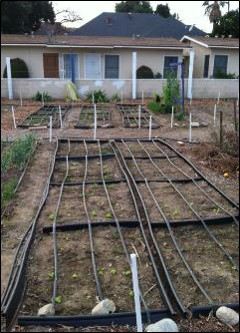
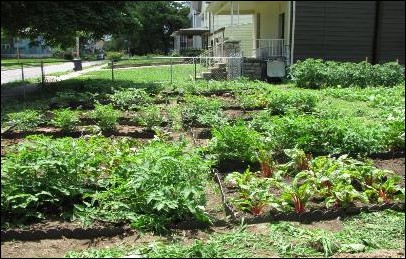
An issue hindering the rapid implementation of urban gardens in many areas is the concern of growing food in soil that may not be safe. Research is making information available to address these misgivings, however knowledge in reference to assessing the risks associated with urban gardening is still lacking in certain facets. Lead (Pb) contamination remains the primary culprit in a multitude of urban areas. The heavy metal, an artifact of anthropogenic activity, has descended upon the soil primarily as a result of the prolonged use of leaded gasoline in the internal combustion engine and leaded paint applied inside and out of many buildings from approximately the 1920’s until 1996 and 1978 in the United States, respectively. Human exposure has been linked to a variety of health maladies leading the Center for Disease Control (CDC) to recommend action at blood lead levels (BLL) exceeding 5 µg/dL. Children are especially susceptible to the toxic effects of Pb resulting in developmental impairment due to their high frequency of hand to mouth activity and increased intestinal absorption capabilities. Adults are not immune though. Arsenic (As) poses yet another cause for concern as various chemical forms have been utilized over the years in pressure treated lumber, agrochemicals, and poultry feed as well as a byproduct released to the atmosphere from ore smelting activity. Understanding the mechanisms facilitating exposure to these contaminants as well as others is essential to the implementation of safe urban gardening programs.
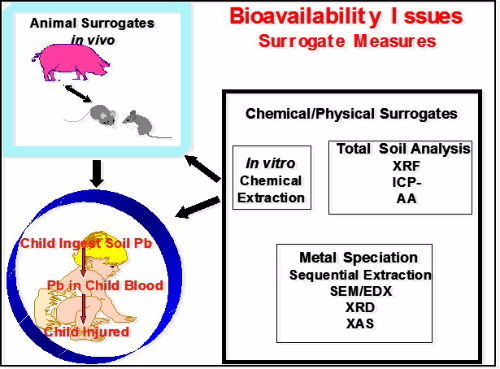
Chammi Attanayake:
Chammi not only investigated the pathway of lead and arsenic uptake from soil to plants, but worked to understand the potential for dermal transfer of polycyclic aromatic hydrocarbons from the soil to human blood.
Dissertation title: Bioavailability of contaminants in urban soils
Phillip Defoe:
Phillip invested a considerable amount of time in testing whether or not common garden plants take lead and arsenic up into their edible portions and what measures may be taken in the garden and the kitchen to mitigate the transfer of contaminants from the soil into the human bloodstream.
Dissertation title: Urban brownfields to gardens : minimizing human exposure to lead and arsenic
Janelle Price:
Janelle looked at the variability of lead and arsenic uptake from variety to variety within the same species of common garden plants grown on urban brownfield sites. She also more closely researched where in the plant the elements concentrated if they were transported into plant tissue.
Joseph Weeks Jr. (Jay):
Jay’s research work also focused on repurposing urban brownfield sites for agricultural production. Besides working with some gardeners to ensure the use of best practices, he tried to quantify the dust inhalation exposure pathway created when cultivating soils contaminated by lead and arsenic.
Dissertation title: Improving environmental health: investigations into soil lead and phosphorus fate and transport
*************************************************************************************************
Wastewater Remediation - Constructed Wetland Treatment Systems
We are part of a multi-disciplinary research group at Kansas State University conducting laboratory and pilot scale evaluations of flue-gas desulfurization (FGD) wastewater to understand transport and transformation of trace elements in constructed wetlands.
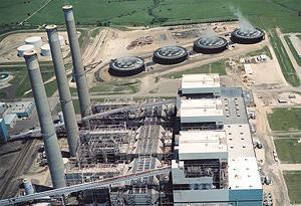
Flue-gas desulfurization technology is being implemented in high sulfur coal-burning electric power plants to comply with Clean Air Act standards by minimizing sulfur dioxide emission in the flue gas. Wastewater generated by FGD systems commonly fail to meet surface water quality standards because of, in general, elevated concentrations of trace metals such as selenium (Se), arsenic (As), and mercury (Hg) as well as many other constituents including sulfur. Constructed wetland treatment systems (CWTS) are being considered to economically treat this wastewater to remove Se and other trace metals. A series of laboratory based continuous up-flow soil column studies mimicking pilot-scale CWTS are being conducted to understand the transport and transformation characteristics of Se and other constituents in FGD wastewater.
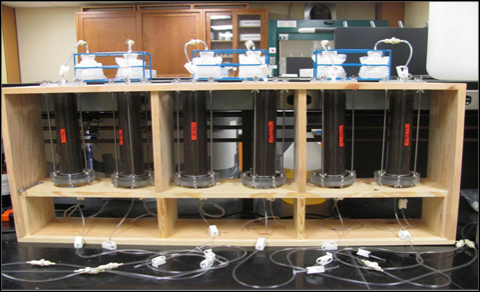
Buddhika Galkaduwa:
Buddhika’s PhD research mainly focused on how different soil treatments and/or conditions influencing the performance of CWTS. The mobility and bioavailability of trace metals such as Se and As depend upon their speciation alter with soil conditions. In addition to the direct effect of redox dynamics, indirect effects due to changing Fe and S biogeochemistry influence Se and As. Therefore, it is important to elucidate the mechanisms of changes in Se, As, Fe and S chemistry in the CWTS. Buddhika’s research is integrating pilot-scale field study observations together with laboratory-based macro-scale, and synchrotron-based X-ray absorption spectroscopy studies such as bulk-X-ray absorption near edge spectroscopy (XANES) and micro-scale x-ray fluorescence mapping in combination with micro-scale XANES, to achieve these objectives.
